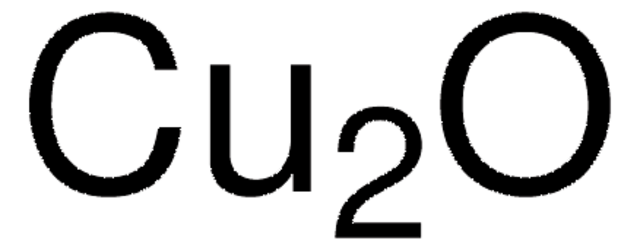678945
Copper(I) oxide
nanospheres, dispersion, <350 nm particle size, 1.5 % (w/v) in ethanol
Sign Into View Organizational & Contract Pricing
All Photos(1)
About This Item
Linear Formula:
Cu2O
CAS Number:
Molecular Weight:
143.09
MDL number:
UNSPSC Code:
12352302
PubChem Substance ID:
Recommended Products
form
dispersion
reaction suitability
reagent type: catalyst
core: copper
concentration
1.5 % (w/v) in ethanol
particle size
<350 nm
SMILES string
[Cu]O[Cu]
InChI
1S/2Cu.O
InChI key
BERDEBHAJNAUOM-UHFFFAOYSA-N
Application
Used to make CuO gas sensors and CuO nanospheres.
Signal Word
Danger
Hazard Statements
Precautionary Statements
Hazard Classifications
Aquatic Acute 1 - Aquatic Chronic 1 - Eye Irrit. 2 - Flam. Liq. 2
Storage Class Code
3 - Flammable liquids
WGK
WGK 3
Flash Point(F)
57.2 °F
Flash Point(C)
14 °C
Personal Protective Equipment
dust mask type N95 (US), Eyeshields, Gloves
Choose from one of the most recent versions:
Already Own This Product?
Find documentation for the products that you have recently purchased in the Document Library.
Customers Also Viewed
Chemistry of Materials, 18, 867-871 (2006)
Jay Singh et al.
The journal of physical chemistry. B, 117(1), 141-152 (2012-12-29)
The ultrafine monodispersed cuprous oxide (Ufm-Cu(2)O) nanoparticles have been successfully synthesized by a facile wet chemical method using poly-N-vinylpyrrolidone (PVP) as a capping agent. This colloidal solution of Ufm-Cu(2)O and chitosan (CS) is electrophoretically deposited (EPD) onto the indium tin-oxide
E Rezabal et al.
Physical chemistry chemical physics : PCCP, 15(4), 1148-1153 (2012-12-12)
The activation of methane and its subsequent conversion into more valuable feedstocks under ambient conditions are regarded as one of the major challenges in contemporary catalysis, due to its thermodynamically strong and kinetically inert C-H bond. Several enzymes and synthetic
Wenwu Shi et al.
ACS applied materials & interfaces, 4(10), 5590-5607 (2012-09-19)
Fabrication of oxide nanowire heterostructures with controlled morphology, interface, and phase purity is critical for high-efficiency and low-cost photocatalysis. Here, we have studied the formation of copper oxide-cobalt nanowire heterostructures by sputtering and subsequent air annealing to result in cobalt
Shengsen Zhang et al.
Applied microbiology and biotechnology, 96(5), 1201-1207 (2012-06-29)
In this work, we report the use of a non-toxic nanocrystal Cu(2)O-loaded TiO(2) nanotube array (Cu(2)O/TNTs) film as high-performance visible-light bactericidal photocatalyst. The samples were characterized by field-emission scanning electron microscopy, X-ray photoelectron spectroscopy, and ultraviolet-visible diffusion reflection spectroscopy. This
Our team of scientists has experience in all areas of research including Life Science, Material Science, Chemical Synthesis, Chromatography, Analytical and many others.
Contact Technical Service










